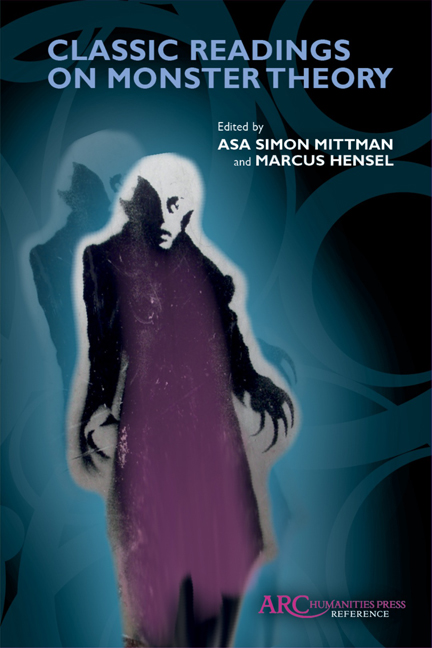“Monster Culture (Seven Theses)”
Published online by Cambridge University Press: 23 January 2021
Summary
WHAT I WILL propose here by way of a first foray, as entrance into this book of monstrous content, is a sketch of a new modus legendi: a method of reading cultures from the monsters they engender. In doing so, I will partially violate two of the sacred dicta of recent cultural studies: the compulsion to historical specificity and the insistence that all knowledge (and hence all cartographies of that knowledge) is local. Of the first I will say only that in cultural studies today history (disguised perhaps as “culture”) tends to be fetishized as a telos, as a final determinant of meaning; post de Man, post Foucault, post Hayden White, one must bear in mind that history is just another text in a procession of texts, and not a guarantor of any singular signification. A movement away from the longue durée and toward microeconomics (of capital or of gender) is associated most often with Foucauldian criticism; yet recent critics have found that where Foucault went wrong was mainly in his details, in his minute specifics. Nonetheless, his methodology—his archaeology of ideas, his histories of unthought—remains with good reason the chosen route of inquiry for most cultural critics today, whether they work in postmodern cyberculture or in the Middle Ages.
And so I would like to make some grand gestures. We live in an age that has rightly given up on Unified Theory, an age when we realize that history (like “individuality,” “subjectivity,” “gender,” and “culture”) is composed of a multitude of fragments, rather than of smooth epistemological wholes. Some fragments will be collected here and bound temporarily together to form a loosely integrated net—or, better, an unassimilated hybrid, a monstrous body. Rather than argue a “theory of teratology,” I offer by way of introduction to the essays that follow a set of breakable postulates in search of specific cultural moments. I offer seven theses toward understanding cultures through the monsters they bear.
Thesis I: The Monster's Body Is a Cultural Body
Vampires, burial, death: inter the corpse where the road forks, so that when it springs from the grave, it will not know which path to follow.
- Type
- Chapter
- Information
- Classic Readings on Monster Theory , pp. 61 - 76Publisher: Amsterdam University PressPrint publication year: 2018

